The Subaru Legacy Still Holds This Incredible Speed Record from 1989
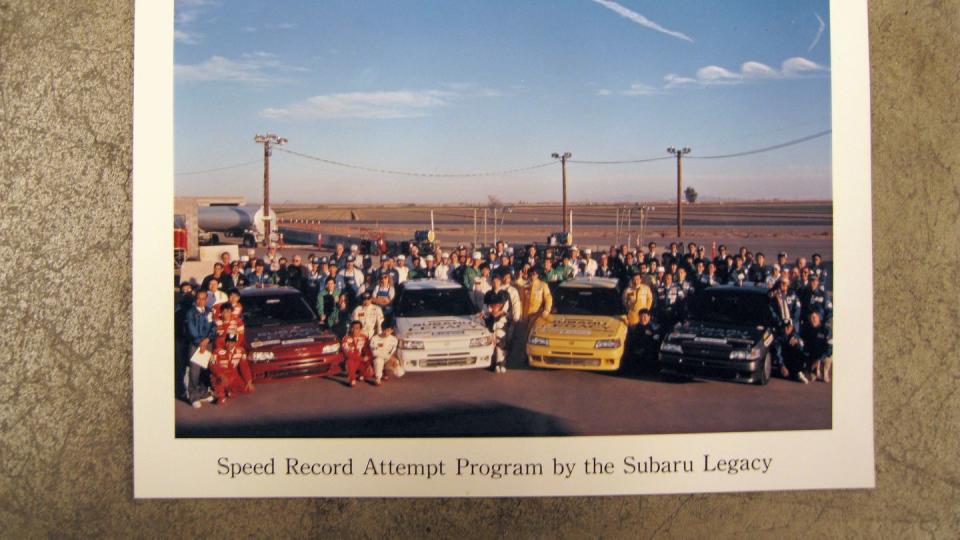

As of spring 2025, the Subaru Legacy is dead, and we are all sad. But maybe not too sad. The Legacy doesn't really sell in appreciable quantities anymore. There are more efficient and attractive offerings out there, such as the new Toyota Camry, and, generally speaking, the mid-size sedan segment is as unfashionable in this modern era as polyester pants or lane discipline.
The Legacy delivered on its mission, and now it is time to retire. It can rest easy knowing it has handed over the reins to the Outback, the only wagon America really cares about, and drive off to that great big Trader Joe's parking lot in the sky.
As we look back on the Legacys, er, legacy, there are several performance-related bright spots to point out. In the World Rally Championship, a Prodrive-prepared Legacy was the chariot for Colin MacRae's first WRC victory, taking the 1993 Rally New Zealand when he was just 25 years old. On the street, turbocharged Legacys provided a dash of excitement in a more grown-up fashion than the WRX, in particular the 2006–2009 Spec B variant. And the availability of a flat-six engine for two decades was an interesting choice.
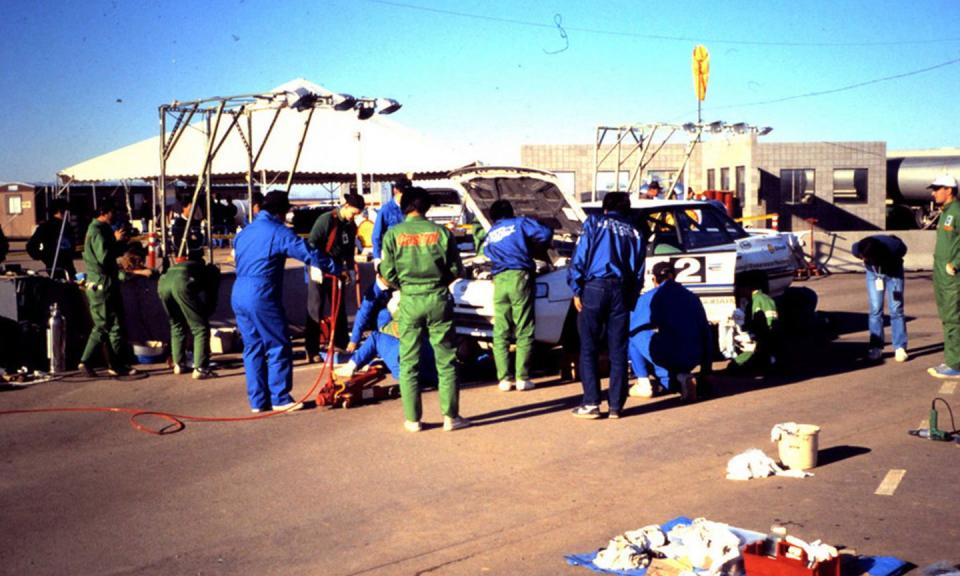
However, the Legacy's most lasting achievement overshadows all of the aforementioned, and it happened at the very dawn of the nameplate. In fact, it was achieved before dawn, at 3:11 a.m., on a banked circuit in the middle of the Arizona desert. Thirty-five years ago, supported by a small army of Subaru employees, three Japanese-spec Legacys went the distance, setting an FIA record for speed and endurance that still boggles the mind.
More than 18 days at full throttle, hour after hour at 145 mph, through early frost and desert rainstorms. Turbochargers glowing cherry red in the dark and flat-four engines sputtering an offbeat roar that would become the calling card of rally-bred performance.
Over 62,137 miles (100,000 kilometers), all three Legacys endured, the fastest of them managing an average speed of 138 mph. In the record category for engines between 1.5 and 2.0 liters, it's never been beaten. Now that it's nearly time to write the epitaph on the tombstone of Subaru's mid-size sedan, here's the nearly forgotten story of what the Legacy was capable of.
Into the Dark
"Prior to the introduction of the Legacy, Subaru was a pretty quirky car company with some pretty odd cars," says Tony Pearson, who was working for Subaru of America's tech center at the time and was directly involved in the record attempt. "With the Legacy, there was the sense that here was something that could compete with the Camry or the Accord."
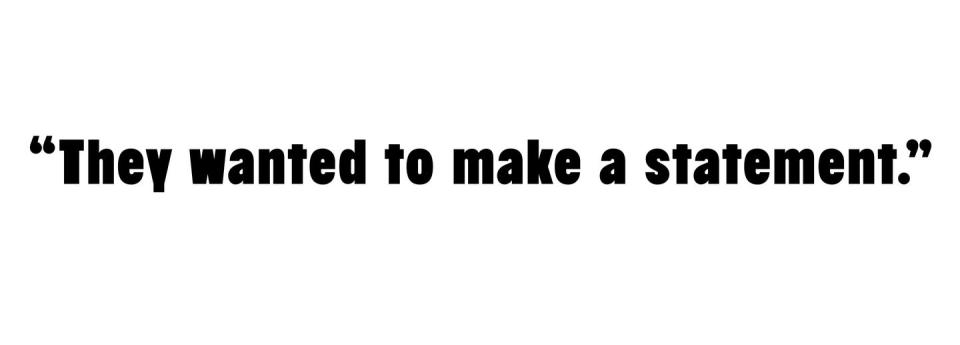
In 1988, Subaru's U.S. sales numbers were in slow decline, sliding down from a peak of roughly 180,000 in 1986. It was a transition period, as though Subaru were metamorphosing from Saab to Volvo, from unusual and beloved to a safe choice with more mainstream appeal. The Legacy would be part of that change, but it didn't really turn things around until the mid-Nineties, around the time of the introduction of the Outback.
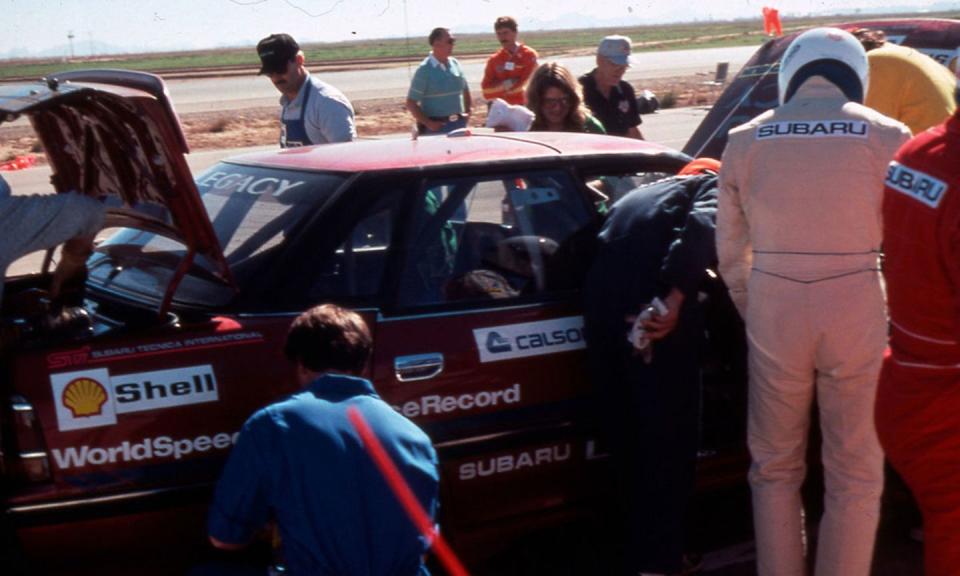
Nevertheless, Subaru had ambition and optimism combined in the person of Noriyuki Koseki, founder of Subaru Technica International (STI). Koseki raced a Subaru GL in the Baja 500 in 1973, created the Subaru Rally Team Japan that entered Safari Rally in Group A in the Eighties, and later had STI partner with Prodrive to enter WRC racing.
Koseki was at the heart of the record attempt with Mitsuo Takahashi, an engineer who had been the director in the Leone's development back in the early Seventies. From Fuji Heavy Industries, 100 employees were chosen both for their skill and as a reward for faithful duty. In October 1988, the official decision was made to prepare.
"It was specifically worded as a record attempt," says Pearson. "They weren't sure that the cars could actually achieve this, but they were going to try."
Subaru City
On the night of December 12, 1988, four specially prepared Japanese-market Legacy RS models were loaded into a cargo 747 at Narita International Airport on the outskirts of Tokyo. The cars had been modified in accordance with FIA rules by Koseki's small team at STI, and they were bound for the Arizona desert.
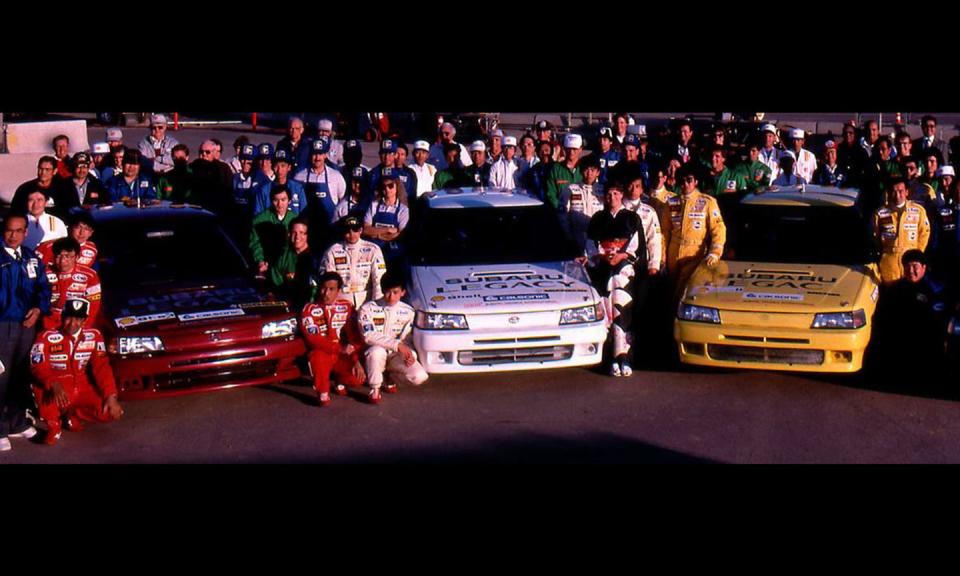
Specifically, the four Legacys were being shipped to the 5.7-mile Auto Test Center (ATC) banked oval, located an hour south of Phoenix. A joint venture between Nissan and Calsonic, a Japanese parts supplier now merged with Marelli, the ATC was used as a crucible for testing cooling under the baking desert sun. In January of 1989, temperatures were low and the facility sat empty.
Calsonic was Subaru's in at the ATC, as it supplied many components to its factories. Along with technicians from Michelin and Castrol, a few Subaru of America employees, and even a few University of Arizona students, the 100-member Fuji Heavy Industry staff set up shop in a series of outbuildings, tents, and temporary pit areas. They called the area Subaru City.
FIA scrutineers examined the cars and judged them worthy. Allowable modifications included some mild aerodynamic tweaks—perhaps most observable are the aero wheel covers and the blanked-off grille—and safety considerations, such as a roll cage, fire suppression, and a trunk-mounted fuel cell. The Japanese-market turbocharged EJ20 flat-four engines made about 230 hp.
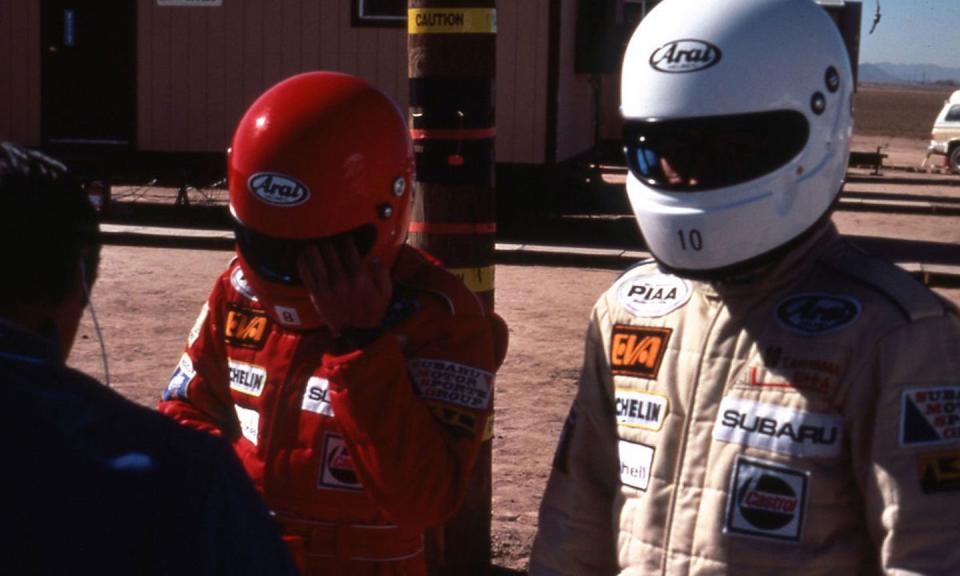
Subaru's engineers left nothing to chance. Multiple test runs were performed to get pit-stop procedures and driver changes down pat. The data center fitted antennae and readied their dot matrix printers. And on January 2nd at 11:27 a.m. local time, the cars set off.
Legacy: 3, Rabbit: 0
"For the first few days, things were pretty hectic," Pearson says. "Then things settled into a routine. The excitement level did come down a bit."
The magnitude of this undertaking can't be overstated. Never mind Le Mans: The longest race in the world was the 84-hour Marathon de la Route held between 1969 and 1971, and the Legacys were expected to run five times as long.
And again, these were largely factory-spec mid-size sedans. And while the crew servicing them was talented, it was comprised of Subaru employees rather than experienced racing pit-crew members. The 24 drivers were also employees rather than professional racers, running two-hour stints at the wheel in three eight-hour shifts of six people per day.
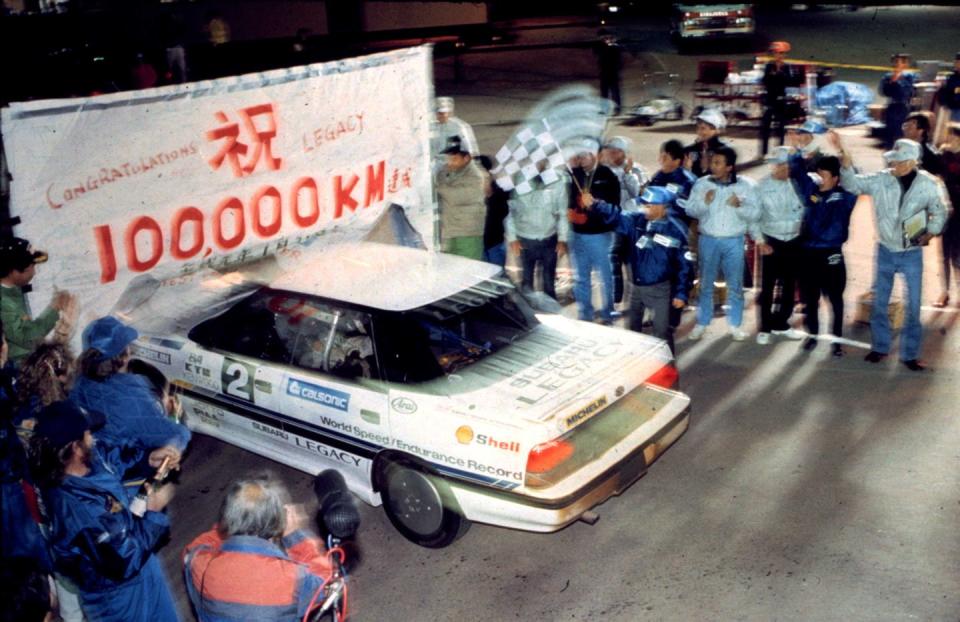
But as first-day jitters passed, Pearson says things operated like clockwork. The Castrol techs checked the oil at regular intervals. The Michelin team recorded tire wear, replacing the tires every 96 hours. Regular stops took roughly two minutes. Shuttles took staff to and from the site, back to a hotel in nearby Standfield.
There were some unexpected factors. Heavy rain caused a slowdown from 145 mph to about 135. The wind picked up and tumbleweeds started becoming moving obstacles. In an NHK film shot during the attempt, one worker races to grab a pair before they roll onto the track, something he almost surely did not expect to be doing when he was hired on at Subaru.
The white No. 2 Legacy also had a few minor issues, with a leaking oil line causing a small fire and the right rear wheel bearing starting to fail. It was also the Legacy that pulled an Elmer Fudd and wiped out an incautious jackrabbit about two-thirds of the way into the attempt.

But, in the wee hours of January 21st, it was the car that crossed the line first, having also set the 50,000-mile speed record. The No. 1 and No. 3 cars finished a few hours later, each being driven through a banner commemorating the achievement. More than 62,000 miles at an average of 138.78 mph. World record set.
"There was a lot of emotion there at the finish," says Pearson. "Just a really cool, cool moment in time."
The Long Reset
This successful speed-record attempt was intended to be a new beginning for Subaru. Instead, it was a bright spot in a dark time, and one that didn't ever fully realize its potential. The Legacy eventually became part of Subaru's ascension in the U.S., but the company would have to struggle along during some lean years first.

Subaru only ever made a single commercial to celebrate its achievement, and an odd one at that, featuring a rabbit, raccoon, lizard, and owl gawking at a red Legacy endlessly looping a track. "Subaru would like to apologize to the residents of Casa Grande, Arizona," said the voice-over. Well, I should hope so, at least where the rabbit is concerned.
So much more could have been said here about the engineering required to survive the mechanical torture of a full two and a half weeks spent lapping at 140 mph. Meanwhile, as the Legacy went on to compete in rallying at the highest level, that message didn't really reach a U.S. audience. It would take the Impreza to do that.
Pearson says the victory was like a blip in time. The mayor of Casa Grande allowed the cars to be driven into town, and a huge celebration followed. The sake flowed, trinkets and commemorative jackets were handed out, and then Subaru and the four Legacys went home.

The record-setting No. 2 Legacy still exists and was recently shown alongside some other historic Subarus at a dealership in Ota, Japan. It is the template for all STI-branded Subarus, as by November 1989, Koseki and his team had launched the Legacy RS Type RA, a limited-edition sedan, each of the one hundred examples painted white. Over the years, only the most special Subaru performance cars have worn the RA designation.
But you can't buy an STI anymore, and soon, you won't be able to get a Legacy. And sure, more enthusiast tears have been spilled over the former rather than the latter.
But that speed record still exists, more than three decades later. Right from its first beginnings, the Legacy was made to go the distance.

A car-loverHearst Owned
You Might Also Like

 Yahoo Autos
Yahoo Autos 